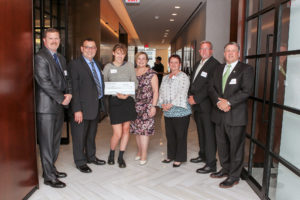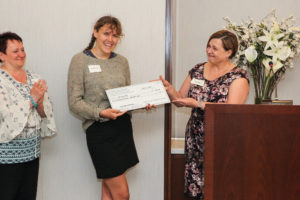
Virginia student highlights building codes
 The Virginia Department of Housing and Community Development, the Virginia Plumbing and Mechanical Inspectors Association, and the Virginia Building and Code Officials Association partnered to host a Building Safety Month essay contest for Virginia high school and college students. This year’s first place winner is Thea Konefal who was honored at the International Code Council’s Building Safety Month celebration at the headquarters of the Laborers’ International Union of North America on May 30 in Washington, D.C. She will graduate this June from the Maggie L. Walker Governor’s School for Government and International Studies. Below is her award-winning submission, “The Quiet Work of Building Codes.”
The Virginia Department of Housing and Community Development, the Virginia Plumbing and Mechanical Inspectors Association, and the Virginia Building and Code Officials Association partnered to host a Building Safety Month essay contest for Virginia high school and college students. This year’s first place winner is Thea Konefal who was honored at the International Code Council’s Building Safety Month celebration at the headquarters of the Laborers’ International Union of North America on May 30 in Washington, D.C. She will graduate this June from the Maggie L. Walker Governor’s School for Government and International Studies. Below is her award-winning submission, “The Quiet Work of Building Codes.”
The Quiet Work of Building Codes
We recently had a storm blow through Richmond, causing a rainy and extremely windy night. There were leaves and limbs all over the neighborhood the next morning, and along my route to school, an enormous tree had fallen over. As I stepped around it walking to school, I thought about the huge force the wind created, enough to topple this 100-year-old giant, trapping a car in a parking lot. But despite the powerful wind, all the buildings in my neighborhood were fine. This is the real life effect of building codes.
When building codes work best, nobody really notices! That fact makes it harder for people to realize all the ways that codes affect the safety of their communities, because the success of the codes lies in tragic events that are prevented: buildings that don’t blow over, decks that don’t collapse, electrical fires that don’t ignite. For that reason, I thought I’d show how the building codes affect my personal safety and the safety of the people in my community by describing a normal day in my life, and thinking about the disasters that don’t, in fact, happen.
I wake up in a wonderfully sturdy old house with light pouring through my windows, casting wavy patterns through the glass onto the opposite wall. It was built in 1910, before the current residential codes were in effect. But changes to the structural framing, electrical system, or plumbing needed to be approved by code officials over the years. Following this review process is the way to ensure that my house and all the houses in the neighborhood keep up with safety standards, and it’s a way to make sure that people doing the work don’t cut comers. Building code enforcement is a check on quality.
Ready to get the day started, I turn on the gas burner to heat up some water on the stove. The building code has provisions for properly connecting and inspecting the natural gas lines. A gas leak and a spark make a volatile combination. There are cases where unregulated connections made to a gas line have caused explosions, but that doesn’t happen here. Instead, I peacefully heat my water for tea. Lovely!
When I take a shower and use the bathroom … again no disasters: no leaks, no scalding water, no unfortunate backups! The building code outlines how plumbing must be installed in houses so fresh water flows in and waste water goes out. Because the building code was enforced, it all works uneventfully like it’s supposed to do.
If I flip on the light or hair dryer, they, too, work just fine. Following the code with electrical renovations means that no wires are overloaded. Proper adherence to the electrical code prevents overheated wires and fires.
On my way to school I pass the massive roots and trunk from the overturned tree, but again, it makes me appreciate that the houses are unscathed. Where I live, all of the houses — not just my own — are from the early twentieth century, so they fall under the “maintenance code,” which ensures that old buildings remain safe and in good condition over their lifetimes. This benefits my community because we get to have beautiful old buildings that stay safe for generations.
I then get to school, where the code may be even more important in preventing tragedies. My school is in a renovated older building, proudly standing since 1937. The “Existing Building Code” specifically addresses changes and additions to rehabilitated structures, and because the code was used in the design of the building and enforced during construction, the students and teachers in the building will probably, again, never notice the role it plays.
One big issue with schools is that they’re used as emergency shelters when a disaster such as a hurricane hits a community. Because of this possibility, the code mandates that this type of building should be somewhat stronger than buildings used for other purposes, and that there have to be enough exits so that everyone can get out in case of a fire. Even without a disaster, the building code affects the safety of the students in smaller ways. The hallways are wide enough so that everyone can move around the building. There are handrails at all the stairs so nobody trips or falls, and they are designed so that no one pinches her fingers. There are ramps and elevators so that people in wheelchairs or with crutches can move around with everyone else.
We rarely hear about the heating system or the air conditioning because the building is warm in winter and cool in summer. The building code provides the requirements for these essential building systems to make sure they have the capacity to do their job. It also requires that enough insulation is used so that less heating and cooling is wasted, which benefits me because I’m comfortable at school, but also benefits the community because it saves energy.
As day heads into night, I go with friends to see a band play at a venue that often gets crowded. Here again, the building code is doing its work without anyone noticing because as people dance and bounce, the floor is just fine. If we needed to exit in a hurry, there are plenty of doors, and the doors are wide enough to allow everyone to get out. One more time, no disasters.
It’s been, fortunately, an uneventful day as far as safety goes. The code and its enforcement are vital so that the buildings that we live in, learn in, and dance in are designed and built in a way that ensures we can enjoy them safely. A storm may, sadly, uproot a beautiful tree, but the structures around it stand strong. Nobody notices the quiet work of the building code because it has worked exactly as it was designed to do.
 Thea will graduate this June from the Maggie L. Walker Governor’s School for Government and International Studies in Richmond, Va. Currently, she is president of her school’s environmental club and she co-runs a tutoring program for area children. In the fall, she will attend Barnard College at Columbia University to possibly study urban studies.
Thea will graduate this June from the Maggie L. Walker Governor’s School for Government and International Studies in Richmond, Va. Currently, she is president of her school’s environmental club and she co-runs a tutoring program for area children. In the fall, she will attend Barnard College at Columbia University to possibly study urban studies.







